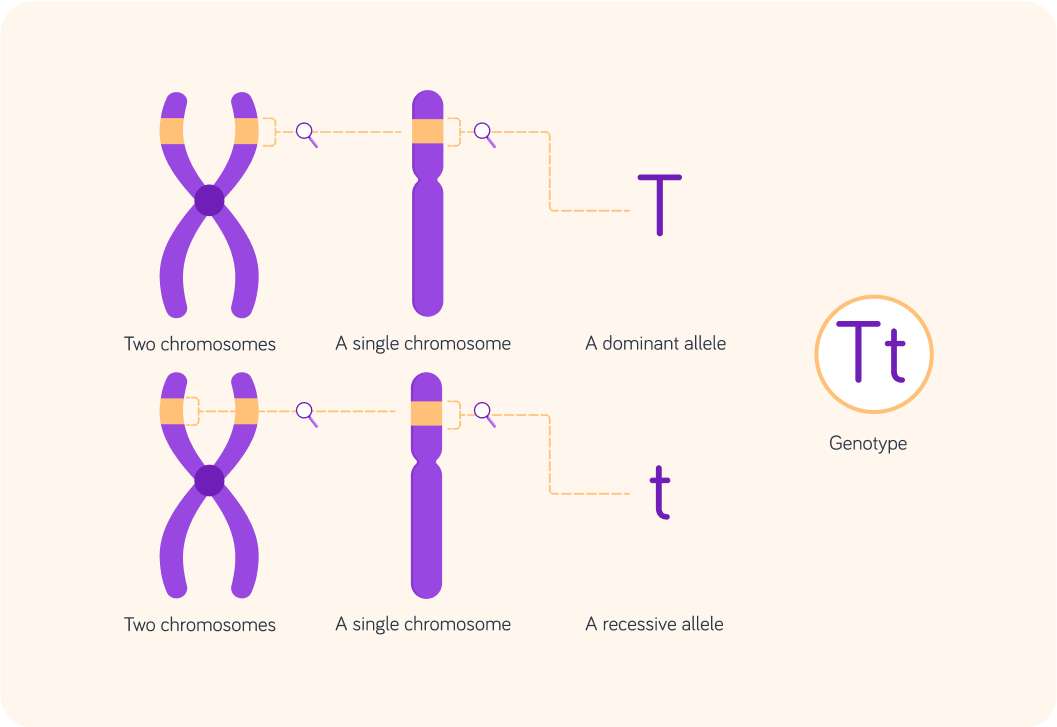YOU ARE LEARNING:
Variation

Variation
A gene is a section of DNA that codes for a particular protein. Genes come in different forms, called alleles. Different alleles can produce different phenotypes - the characteristics we can see.
In previous lessons, we discussed what a gene is. Do you remember?

Remember that chromosomes come in pairs. On one chromosome there are many genes, each coding for a particular trait. Say one of these genes codes for eye colour. On that gene there is an allele (a specific form of that gene), coding for a particular type of the trait. In this case it codes for blue eyes rather than say brown eyes.
But what about the other chromosome in the pair? The genes in the other chromosome code for the same traits, but it could have different alleles. So the other chromosome in a pair could have the brown eye allele!
Say you have a chromosome pair where the genes for eye colour has a blue eyes allele on one chromosome and a brown eyes allele on the other. How do you think the alleles work out if the person should have blue eyes or brown eyes?

We call the stronger allele the dominant one. The weaker allele we call the recessive one.
So, a gene has different forms. What is a variant of a gene called?

The alleles you inherit from your parents help decide what characteristics you express.
Everyone has a pair of genes for a single trait. Where are these genes kept?

Which of these statements do you think is correct?

Examples of traits controlled by just one gene are fur colour in mice, and red-green colour blindness in humans. However, the vast majority of traits are the result of several genes working together.
With traits that are controlled by a single gene, how many alleles will be involved in the expression of the trait?

Imagine the trait is a mouse's fur colour, which is brown. The mouse might have two alleles, one coding for brown fur and one coding for grey fur. The dominant brown allele 'wins', and brown fur is expressed in the phenotype. In other words, what we see is brown fur.
Have a good look at this image
It's important to remember though, that the phenotype isn't only determined by the genotype. The environment also counts!

If a plant receives no nutrients, no water and no sunlight, will it grow tall? Answer yes or no.


Is it possible that a plant whose genes code for short grows taller than a plant whose genes code for tall? Answer yes or no.


What is your genotype?

While the standard definition of the genotype is your complete set of DNA, the word can also be used in another sense.
Remember Mendel with his traits in pea plants? When talking about alleles and genes, an allele pair can also be described as a genotype. For example, we can also refer to TT for a tall plant as the genotype for that specific trait.
What is the genotype in terms of alleles?

What is your phenotype?

What is your phenotype in terms of alleles?

This diagram shows the relationship between chromosomes, genes and alleles that are expressed. How many genes for a particular trait is on one chromosome in a chromosome pair?


How many alleles for a trait are there on each gene?


The alleles that help determine a particular trait can be described as dominant and recessive. Depending on the combination, the pairs can be described as homozygous or heterozygous. More on that in another lesson, though.
